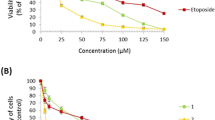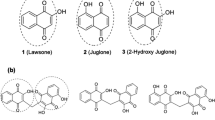Summary
In the present study, the antitumoral properties of a series of 7-chloroquinoline-1,2,3-triazoyl-carboxamides (QTCA) were investigated by analyzing their cytotoxic activities against human bladder cells (5637; grade II carcinoma). In addition, their effects on cell viability, cell cycle arrest mechanisms, apoptosis induction, in silico molecular docking, and detection of pro-apoptotic and anti-apoptotic proteins were evaluated. The cytotoxicity assay identified major dose- and time-dependent cytotoxic effects in 5637 cells after they were exposed to treatment with QTCA, only minimal effects were observed on normal cells. A live/dead assay confirmed that significant cell death, arrest in the G0/G1 phase and apoptosis were associated with treatment by 1-(7-Chloroquinolin-4-yl)-5-methyl-N-phenyl-1H-1,2,3-triazole-4-carboxamide (QTCA-1) and 1-(7-Chloroquinolin-4-yl)-N-(4-fluorophenyl)-5-methyl-1H-1,2,3-triazole-4-carboxamide (QTCA-4). The in silico results indicated that these compounds acted through different mechanisms for the induction of cell cycle arrest and apoptosis. Western blotting confirmed the binding of the QTCAs to pro- and anti-apoptotic proteins. In conclusion, QTCA-1 and QTCA-4 are promising candidates for inducing cytotoxicity, cell cycle arrest, and apoptosis in human bladder cancer cells.








Similar content being viewed by others
References
Siegel RL, Miller KD, Jemal A (2017) Cancer Statistics, 2017. 67:7–30. https://doi.org/10.3322/caac.21387
American Cancer Society (2018) Cancer Facts & Figures 2018. https://www.cancer.org/content/dam/cancer-org/research/cancer-facts-and-statistics/annual-cancer-facts-and-figures/2018/cancer-facts-and-figures-2018.pdf
Yeung C, Dinh T, Lee J (2014) The health economics of bladder Cancer: an updated review of the published literature. Pharmacoeconomics 32:1093–1104. https://doi.org/10.1007/s40273-014-0194-2
Eifler JB, Scarpato KR, Clark PE (2015) Management of noninvasive bladder cancers. Curr Opin Oncol 27:185–190. https://doi.org/10.1097/CCO.0000000000000173
Sanli O, Dobruch J, Knowles MA, Burger M, Alemozaffar M, Nielsen ME, Lotan Y (2017) Bladder cancer. Nat Rev Dis Prim:31–19. https://doi.org/10.1038/nrdp.2017.22
Su H, Jiang H, Tao T, Kang X, Zhang X, Kang D, Li S, Li C, Wang H, Yang Z, Zhang J, Li C (2019) Hope and challenge: precision medicine in bladder cancer. Cancer Med 8:1806–1816. https://doi.org/10.1002/cam4.1979
Tomaszewski JJ, Smaldone MC (2010) Emerging intravesical therapies for management of nonmuscle invasive bladder cancer. Open Access J Urol 2:67–84
Logan C, Brown M, Hayne D (2012) Intravesical therapies for bladder cancer – indications and limitations. BJU Int 110:12–21. https://doi.org/10.1111/j.1464-410X.2012.11619.x
Grossman HB, O’donnell MA, Cookson MS, Greenberg RE, Keane TE (2008) Bacillus calmette-guerin failures and beyond: contemporary management of non-muscle-invasive bladder cancer. Rev Urol 10(4):281–289
Pfeffer CM, Singh ATK (2018) Apoptosis: a target for anticancer therapy. Int J Mol Sci 19(2):448. https://doi.org/10.3390/ijms19020448
Lednicer D (2007) The organic chemistry of drug synthesis. Wiley 7. https://doi.org/10.1002/9780470180679
Kumar S, Bawa S, Gupta H (2009) Biological activities of Quinoline derivatives. Mini-Reviews Med Chem 9:1648–1654. https://doi.org/10.2174/138955709791012247
Wilhelm EA, Machado NC, Pedroso AB, Goldani BS, Seus N, Moura S, Savegnago L, Jacob RG, Alves D (2014) Organocatalytic synthesis and evaluation of 7-chloroquinoline-1,2,3-triazoyl carboxamides as potential antinociceptive, anti-inflammatory and anticonvulsant agent. RSC Adv 4:41437–41445. https://doi.org/10.1039/C4RA07002J
Manera C, Cascio MG, Benetti V, Allarà M, Tuccinardi T, Martinelli A, Saccomanni G, Vivoli E, Ghelardini C, Di Marzo V, Ferrarini PL (2007) New 1,8-naphthyridine and quinoline derivatives as CB2 selective agonists. Bioorg Med Chem Lett 17:6505–6510. https://doi.org/10.1016/j.bmcl.2007.09.089
Dorey G, Lockhart B, Lestage P, Casara P (2000) New quinolinic derivatives as centrally active antioxidants. Bioorg Med Chem Lett 10:935–939. https://doi.org/10.1016/S0960-894X(00)00122-0
Saraiva MT, Krüger R, Baldinotti RSM, Lenardão EJ, Luchese C, Savegnago L, Wilhelm EA, Alves D (2016) 7-chloroquinoline-1,2,3-triazoyl carboxylates: Organocatalytic synthesis and antioxidant properties. J Braz Chem Soc 27:41–53. https://doi.org/10.5935/0103-5053.20150239
Naik HRP, Naik HSB, Naik TRR, Naika HR, Gouthamchandra K, Mahmood R, Ahamed BMK (2009) Synthesis of novel benzo[h]quinolines: wound healing, antibacterial, DNA binding and in vitro antioxidant activity. Eur J Med Chem 44:981–989. https://doi.org/10.1016/j.ejmech.2008.07.006
Nayyar A, Malde A, Coutinho E, Jain R (2006) Synthesis, anti-tuberculosis activity, and 3D-QSAR study of ring-substituted-2/4-quinolinecarbaldehyde derivatives. Bioorg Med Chem 14:7302–7310. https://doi.org/10.1016/j.bmc.2006.06.049
Bawa S, Kumar S, Drabu S, Kumar R (2010) Structural modifications of quinoline-based antimalarial agents: recent developments. J Pharm Bioallie Sci 2:64. https://doi.org/10.4103/0975-7406.67002
Clemence F, Le Martret O, Delevallee F, Benzoni J, Jouanen A, Jouquey S, Mouren M, Deraedt R (1988) 4-hydroxy-3-quinolinecarboxamides with Antiarthritic and analgesic activities. J Med Chem 31:1453–1462. https://doi.org/10.1021/jm00402a034
Wallace OB, Lauwers KS, Jones SA, Dodge JA (2003) Tetrahydroquinoline-based selective estrogen receptor modulators (SERMs). Bioorg Med Chem Lett 13:1907–1910. https://doi.org/10.1016/S0960-894X(03)00306-8
Begnini KR, Duarte WR, da Silva LP, Buss JH, Goldani BS, Fronza M, Segatto NV, Alves D, Savegnago L, Seixas FK, Collares T (2017) Apoptosis induction by 7-chloroquinoline-1,2,3-triazoyl carboxamides in triple negative breast cancer cells. Biomed Pharmacother 91:510–516. https://doi.org/10.1016/j.biopha.2017.04.098
Wall ME, Wani MC, Cook CE, Palmer KH, McPhail AI, Sim GA (1966) Plant antitumor agents. I. the isolation and structure of camptothecin, a novel alkaloidal leukemia and tumor inhibitor from Camptotheca acuminate. J Am Chem Soc 88:3888–3890
Ulukan H, Swaan PW (2002) Camptothecins, a review of their chemotherapeutical potential. Drugs 62:2039–2057. https://doi.org/10.1016/j.ejmech.2013.01.058
Melo JOF, Donnici CL, Augusti R, Ferreira VF, De Souza MCBV, Ferreira MLG, Cunha AC (2006) Heterociclos 1,2,3-triazólicos: Histórico, métodos de preparação, aplicações e atividades farmacológicas. Quim Nova 29:569–579. https://doi.org/10.1590/S0100-40422006000300028
Thomas KD, Adhikari AV, Shetty NS (2010) Design, synthesis and antimicrobial activities of some new quinoline derivatives carrying 1,2,3-triazole moiety. Eur J Med Chem 45:3803–3810. https://doi.org/10.1016/j.ejmech.2010.05.030
Mosmann T (1983) Rapid colorimetric assay for cellular growth and survival: application to proliferation and cytotoxicity assays. J Immunol Methods 65:55–63. https://doi.org/10.1016/0022-1759(83)90303-4
Ferrari M, Fornasiero MC, Isetta AM (1990) MTT colorimetric assay for testing macrophage cytotoxic activity in vitro. J Immunol Methods 131:165–172. https://doi.org/10.1016/0022-1759(90)90187-Z
Hanwell MD, Curtis DE, Lonie DC, Vandermeersch T, Zurek E, Hutchison GR (2012) Avogadro: an advanced semantic chemical editor, visualization, and analysis platform. Aust J Chem 4(1):17. https://doi.org/10.1186/1758-2946-4-17
Morris GM, Huey R, Lindstrom W, Sanner MF, Belew RK, Goodsell DS et al (2009) AutoDock4 and AutoDockTools4: automated docking with selective receptor flexibility. J Comput Chem 30:2785–2791. https://doi.org/10.1002/jcc.21256
Pettersen EF, Goddard TD, Huang CC, Couch GS, Greenblatt DM, Meng EC et al (2004) UCSF Chimera--a visualization system for exploratory research and analysis. J Comput Chem United States 25(13):1605–1612. https://doi.org/10.1002/jcc.20084
Trott O, Olson AJ (2010) AutoDock Vina: improving the speed and accuracy of docking with a new scoring function, efficient optimization and multithreading. J Comput Chem 31:455–461. https://doi.org/10.1002/jcc.21334
Böhm HJ, Banner D, Bendels S, Kansy M, Kuhn B, Müller K, Obst-Sander U, Stahl M (2004) Fluorine in medicinal chemistry. Chem Bio Chem 5:637–643. https://doi.org/10.1002/cbic.200301023
O’Hagan D (2010) Fluorine in health care: Organofluorine containing blockbuster drugs. J Fluor Chem 131:1071–1081. https://doi.org/10.1016/j.jfluchem.2010.03.003
Afzal O, Kumar S, Haider R, Ali R, Kumar R, Jaggi M, Bawa S (2014) A review on anticancer potential of bioactive heterocycle quinolone. Eur J Med Chem:1–40. https://doi.org/10.1016/j.ejmech.2014.07.044
Munchen TS, Sonego MS, De Souza D, Dornelles L, Seixas FK, Collares T, Piccoli BC, D’Avila da Silva F, da Rocha JBT, Quoos N, Rodrigues OED (2018) New 3′ -Triazolyl-5′-aryl-chalcogenothymidine: synthesis and anti-oxidant and Antiproliferative bladder carcinoma (5637) activity. Chemistry Select 3:3479–3486. https://doi.org/10.1002/slct.201800156
Wagner MS, Shultze E, Oliveira TL, De Leon PM, Campos VF, Oliveira I, Souza D, Rodrigues OED, Collares T, Seixas FK (2018) Revitalizing the AZT through of the selenium:na approach in human triple negative breast cancer cell line. Front Oncol (8):525. https://doi.org/10.3389/fonc.2018.00525
Sena-Lopes A, Bezerra FSB, das Neves RN, De Pinho RB, De Oliveira Silva MT, Savegnago L, Collares T, Seixas F, Begnini K, JAP H, Ely MR, Rufatto LC, Moura S, Barcellos T, Padilha F, Dellagostin O, Borsuk S (2018) Chemical composition, immunostimulatory, cytotoxic and antiparasitic activities of the essential oil from Brazilian red propolis. PLoS One 13(2):1–16. https://doi.org/10.1371/journal.pone.0191797
Ooi KK, Yeo CI, Mahandaran T et al (2017) G2/M cell cycle arrest on HT-29 cancer cells and toxicity assessment of triphenylphosphanegold(I) carbonimidothioates, Ph3PAu[SC(OR)=NPh], R=me, et, and iPr, during zebrafish development. J Inorg Biochem 166:173–181. https://doi.org/10.1016/j.jinorgbio.2016.11.008
Sri Ramya PV, Guntuku L, Angapelly S, Karri S, Digwal CS, Babu BN, Naidu VGM, Kamal A (2018) Curcumin inspired 2-chloro/phenoxy quinoline analogues: synthesis and biological evaluation as potential anticancer agents. Bioorg Med Chem Lett 28(5):892–898. https://doi.org/10.1016/j.bmcl.2018.01.070
Rubin E & Farber JL (1999) Neoplasia. In Rubin, E.; Farber, J.L. Pathology. 3 ed. Philadelphia: Lippincott Raven 155–21
Nicholson DW (2000) From bench to clinic with apoptosis-based therapeutic agents. Nature 407:810–816. https://doi.org/10.1038/35037747
Taylor RC, Cullen SP, Martin SJ (2008) Apoptosis: controlled demolition at the cellular level. Nat Rev Mol Cell Biol 9:231–241. https://doi.org/10.1038/nrm2312
Lauber K, Blumenthal SG, Waibel M, Wesselborg S (2004) Clearance of apoptotic cells: getting rid of the corpses. Mol Cell 14:277–287. https://doi.org/10.1016/S1097-2765(04)00237-0
Li SY, Chen YL, Wang C, Tzeng CC (2006) Synthesis and antiproliferative evaluation of certain pyrido[3,2-g]quinoline derivatives. Bioorg Med Chem 14:7370–7376. https://doi.org/10.1016/j.bmc.2006.07.030
Carneiro MLB, Porfírio EP, Otake AH, Chammas R, Báo SN, Guillo LA (2010) Morphological alterations and G0/G1 cell cycle arrest induced by Curcumin in human SK-MEL-37 melanoma cells. Braz Arch Biol Technol 53(2):343–352 ISSN 1516-8913
Zhang Y, Li Z, Min Q, Palida A, Zhang Y, Tang R et al (2018) 8-Chrysoeriol, as a potential BCL-2 inhibitor triggers apoptosis of SW1990 pancreatic cancer cells. Bioorg Chem United States 77:478–484. https://doi.org/10.1016/j.bioorg.2018.01.042
Chandrashekhar R, Ram B, Bhavani NL, Bakshi V (2017) Molecular docking studies of Hydrazide-Hydrazone derivatives of gossypol against Bcl-2 family anti-apoptotic targets. Drug Des 6:155. https://doi.org/10.4172/2169-0138.1000155
Ding J, Mooers BHM, Zhang Z, Kale J, Falcone D, McNichol J et al (2014) After embedding in membranes antiapoptotic Bcl-XL protein binds both Bcl-2 homology region 3 and helix 1 of proapoptotic Bax protein to inhibit apoptotic mitochondrial permeabilization. J Biol Chem 289(17):11873–11896. https://doi.org/10.1074/jbc.M114.552562
Shangary S, Wang S (2009) Small-molecule inhibitors of the MDM2-p53 protein-protein interaction to reactivate p53 function: a novel approach for cancer therapy. Annu Rev Pharmacol Toxicol 49:223–241. https://doi.org/10.1146/annurev.pharmtox.48.113006.094723
Neochoritis CG, Wang K, Estrada-Ortiz N, Herdtweck E, Kubica K, Twarda A, Zak KM, Holak TA, Dömling A (2015) 2,3′-Bis(1′H-indole) heterocycles: new p53/MDM2/MDMX antagonists. Bioorg Med Chem Lett 25:5661–5666. https://doi.org/10.1016/j.bmcl.2015.11.019
Atatreh N, Ghattas MA, Bardaweel SK, Rawashdeh SAL, Sorkhy MAL (2018) Identification of new inhibitors of Mdm2 – p53 interaction via pharmacophore and structure- based virtual screening. Drug Des Devel Ther 12:3741–3752. https://doi.org/10.2147/DDDT.S182444
Song X, Xiong Y, Qi X, Tang W, Dai J, Gu Q et al (2018) Molecular targets of active anticancer compounds derived from marine sources. Mar Drugs Switzerland 16(5):175. https://doi.org/10.3390/md16050175
Estrada-Ortiz N, Neochoritis CG, Domling A (2016) How to design a successful p53-MDM2/X interaction inhibitor: a thorough overview based on crystal structures. Chem Med Chem Germany 11(8):757–772. https://doi.org/10.1002/cmdc.201500487
Campbell KJ, Tait SWG (2018) Targeting BCL-2 regulated apoptosis in cancer. Open Biol 8(5):1–11. https://doi.org/10.1098/rsob.180002
Yip KW, Reed JC (2008) Bcl-2 family proteins and cancer. Oncogene 27:6398–6406. https://doi.org/10.1038/onc.2008.307
Elkholi R, Renault TT, Serasinghe MN, Chipuk JE (2014) Putting the pieces together: how is the mitochondrial pathway of apoptosis regulated in cancer and chemotherapy? Cancer Metab 2:16. https://doi.org/10.1186/2049-3002-2-16
Funding
This study was financed in part by the Coordenação de Aperfeiçoamento de Pessoal de Nivel Superior - Brasil (CAPES)–Finance Code 001.
Author information
Authors and Affiliations
Contributions
Material preparation, data collection and analysis were performed by Mariana S. Sonego, Natália V. Segatto, Lucas Damé, Mariana Fronza, Carolina B. Gomes, Thais Larré Oliveira. Study conception and design were supervised by Fabiana Kömmling Seixas, Lucielli Savegnago, Kyle M. Schachtschneider, Diego Alves and Tiago Collares. The first draft of the manuscript was written by Mariana S. Sonego and all authors commented on previous versions of the manuscript. All authors read and approved the final manuscript.
Corresponding author
Ethics declarations
Conflict of interest
The authors declare that there is no conflict of interest regarding the publication of this article.
Ethical approval
This article does not contain any studies involving the use of human participants or animals.
Informed consent
For this type of study, formal consent is not required.
Additional information
Publisher’s note
Springer Nature remains neutral with regard to jurisdictional claims in published maps and institutional affiliations.
Rights and permissions
About this article
Cite this article
Sonego, M.S., Segatto, N.V., Damé, L. et al. 7-Chloroquinoline-1,2,3-triazoyl carboxamides induce cell cycle arrest and apoptosis in human bladder carcinoma cells. Invest New Drugs 38, 1020–1030 (2020). https://doi.org/10.1007/s10637-019-00861-w
Received:
Accepted:
Published:
Issue Date:
DOI: https://doi.org/10.1007/s10637-019-00861-w




